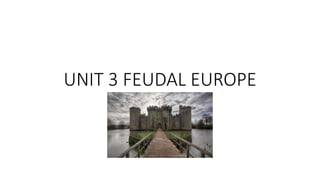
Unit 3 feudal europe
- 1. UNIT 3 FEUDAL EUROPE
- 2. A period of instability • Centuries 9th and 10th:Invasions in western Europe • Form North the Normands (Vikings) • From the South Muslims (Saracens) • From East Hungarians (Magyars)
- 3. Feudalism and vassalage • Monarchs relied on the nobles for support and established a system of relationships called vassalage.
- 4. • The homage and investiture: • Homage: The vassal knelt before the King and promised to be loyal and provide him with military and economic help. • Investitures: The King gave a fiefdom to a vassal.
- 5. Theatre activity • In groups of four represent the vassalage ceremony: • Make a short script with the dialogs between kings and vassals. • This sentence will be compulsory for the vassal "I promise on my faith that I will in the future be faithful to the lord, never cause him harm and will observe my homage to him completely against all persons in good faith and without deceit.“ • This compulsory for the king: “the lord/king promised to always protect the vassal, while the vassal promised to fight for the lord’s command” • The dress will be valued. • http://www.thefinertimes.com/Middle-Ages/vassals-in-the-middle-ages.html
- 6. The priviledged: the nobility. • Castle life:
- 7. Medieval knights • To become a knight it was compulsory to pass this tasks: • First became a page: Learn how to behave among noblemen and women • Secondly during the adolescence they become a squire: carry the lord’s shield and began a gruelling physical an militar training. Under the supervision of a knight. • If the candidate demonstrates the values he will be knigted in the knighting ceremony.
- 8. Create your coat of arms
- 9. Knight’s activities • Main activity it was war, they had a long military learning, to be physically and mentally prepared. • In times of peace they train taking part in tournaments and jousting or hunting. • A knight was also taught in good manners, specially to treat with noble ladies. They had to be treat ladies with great respect and humble. This is know as courtly love.
- 10. The privileged: The clergy • In Europe in Middle Ages the social and spiritual life was controlled by the Church.
- 11. Church regulation of social life • The church was the most important building in any village or city. • The Church organised the ceremonies that marked person’s ife: baptism, marriage, funeral. Festivities: Christmas, Easter… • Religious obligations: Pray every day, go to Mass, fast during lent, confess… • They had to practise charity and give money to the church. • Pilgirmage was recommended to Rome, Jerusalem or Santiago de Compostela.
- 12. Rich and influential institution • The Church was the most influential institution in Medieval Europe. • Accumulated great riches, many members of the clergy held privileged positions. • Owned considerable land and buildings. • It recieved the TITHE: the tenth part of peasants production. • Recived donations from their parishioners. Some of them left the Church their belongings in their wills.
- 13. A Fiefdom: Lords and peasants • Fiefdom: The land under the control of the lord. It was “entailed property”, they could be inherited by the lord’s descendant, but not sold.
- 14. • Manorial rents: • The lord gave plots of land (Holdings) to peasant in exchange for labour and taxes. • The peasants had obligations such as: - Work a certain number of days on the lord’s land. - Give the lord part of the harvest. - Contribute towards the maintenance of the castle and communal services - Offer the lord the first furits of the harvest - Pay for the services of he fiefdom: the oven, the mill, the press, the use of bridges and paths… • The lord’s powers: • Jurisdictional authority, granted by the king: the lord could issue orders, impart justice, collect taxes, impose fines… • Had to guarantee the protection of peasants in his fiefdom.
- 15. Peasants worked the land • Peasants made up 90% of the population in middle ages. • Were responsible for farming the land and raising livestock. Two types of peasants: • Free peasants: Owned their own land, not legally bound to a lord. They the right to get married, leave the fiefdom, learn a trade… • Serfs: Worked the lord’s land and had no personal freedom. They couldn’t leave the fiefdom, get married or leave inheritance without the lord’s permission.
- 16. Parts of the fiefdom • A fiefdom was organised into two big parts: • Lord’s demesne or domain: The best land. The lord reserved for himself. The castle and communal pastures and forest were located here. • Holdings: Plots of land provided to serfs and peasants, which they farmed and built their houses on, in exchange for labour in the demesne and taxes.
